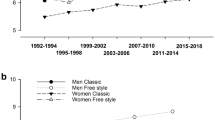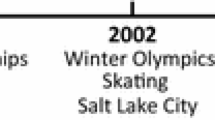Summary
Alpine skiing requires aerobic and anaerobic power, muscular strength, and a variety of complex motor abilities including quickness, agility, balance and coordination.
There is evidence of variability in physical characteristics between skiers of different events. Generally, successful alpine competitors are taller and heavier than in the past. Greater size, specifically lean mass, may be related to technique changes because of the advent of breakaway poles.
Aerobic power, although important, does not discriminate competitors of varying ability categories. Aerobic power is more likely to be a result of conditioning for alpine skiing rather than a profound requirement of the sport.
Anaerobic power is important for skiing and both laboratory and field power tests correlate well with performance. Tests that measure explosive and sustained anaerobic power such as the Wingate, vertical jump, 60-second repeated jump, and Margaria-Kalamen stair run are valuable in assessing skiers. On-snow lactate and oxygen consumption measurements further substantiate the need for high anaerobic power.
Alpine skiers have very high leg strength compared with other athletes. Isokinetic testing has been used to evaluate dynamic leg strength in skiers, but little is known about high speed dynamic or eccentric strength capabilities.
A new mechanism of knee injury that is associated with tibial acceleration has been identified in competitive alpine skiers. A release binding that is sensitive to physiological factors in addition to release forces should be developed. Strength profiling of skiers may also be valuable in evaluating injury risk.
Similar content being viewed by others
References
Andersen RE, Montgomery DL. Physiology of alpine skiing. Sports Medicine 6: 210–221, 1988
Andersen RE, Montgomery DL, Turcotte RA. An on-site battery to evaluate giant slalom skiing performance. Sports Medicine and Physical Fitness 30: 276–282, 1990
Appen L, Duncan PW. Strength relationship of the knee musculature: effects of gravity and sport. Journal of Orthopaedic and Sports Physical Therapy 7: 232–235, 1986
Åstrand PO, Rodahl K. Textbook of work physiology, 3rd ed., McGraw Hill, New York, 1986
Bouter LM, Knipschild PG, Volovics A. Binding function in relation to injury risk in downhill skiing. American Journal of Sports Medicine 17: 226–233, 1989
Brown SL, Wilkinson JG. Characteristics of national, divisional, and club male alpine ski racers. Medicine and Science in Sports and Exercise 6: 491–495, 1983
Eriksson E, Nygaard E, Saltin B. Physiological demands in downhill skiing. Physician and Sportsmedicine 7: 29–37, 1977
Eseltine K, Hull ML. An alpine ski binding with elctronically modulated twist relase. International Journal of Sports Biomechanics 7: 183–200, 1991
Geyer M, Wirth CJ. A new mechanism of anterior cruciate ligament rupture. Unfallchirurg 94: 69–72, 1991
Haymes EM, Dickinson AL. Characteristics of elite male and female ski racers. Medicine and Science in Sports and Exercise 12: 153–158, 1980a
Haymes EM, Dickinson AL. Relationships between laboratory tests and performance in the alpine skiing events. Journal of the United States Ski Coaches Association 4: 29–32, 1980b
Jasmin BJ, Montgomery DL, Hoshizaki. Applicability of the hexagonal obstacle test as a measure of anaerobic endurance for alpine skiers. Sports Training, Medicine and Rehabilitation 1: 155–163, 1989
Karlsson J. Profiles of cross-country and alpine skiers. Clinical Sports Medicine 3: 245–271, 1984
Kornexl E. Anthropometrische Untersuchungen im alpinen Schirennlauf (I Teil). Leibesübungen — Leibeserziehung 29: 196–201, 1975
Kornexl E. Anthropometrische Untersuchungen im alpinen Schirennlauf (II Teil). Leibesübungen — Leibeserziehung 30: 5–8, 1976
Kornexl E. Das sportmotorische Eigenschaftsniveau des alpinen Schirennlaufers, Unpublished doctoral dissertation, University of Innsbruck, 1977
Maxwell SM, Hull ML. Measurement of strength and loading variables on the knee during alpine skiing. Journal of Biomechanics 22: 609–624, 1989
McGinnis PM, Piper FC, Dillman CJ. Skills tests for discrimination of alpine skiing ability. Journal of the United States Ski Coaches Association 4: 20–25, 1981
Neptune R, Hull ML. A new electromechanical ski binding with release sensitivity to torsion and bending momemts transmitted by the leg. International Journal of Sports Biomechanics 8: 331–349, 1992
Orvanova E. Physical structure of winter sports athletes. Journal of Sports Sciences 5: 197–248, 1987
Piper FC, Ward CHT, McGinnis PM, Milner EK. Prediction of alpine ski performance based upon selected anthropometrical and motor dexterity parameters. Journal of Sports Medicine 27: 478–482, 1987
Plisk S. Physiological training for competitive alpine skiing. National Strength and Conditioning Association Journal 10: 30–33, 1988
Richardson RS, Johnson SC, White AT, Seifert JG. Serial lactates in elite alpine skiers. Sports Medicine, Training and Rehabilitation 3: 220, 1992
Saibene F, Cortili G, Gavazzi P, Magistri P. Energy sources in alpine skiing (giant slalom). European Journal of Applied Physiology 53: 312–316, 1985
Shea JB. The alpine skiing assessment battery: the secret to pick- ing the right people and training for the right things. Journal of the United States Ski Coaches Association 6: 26–31, 1983
Song TMK. Relationship of physiological characteristics to skiing performance. Physician and Sportsmedicine 10: 97–102, 1982
Steadman JR, Swanson KR, Atkins JW, Hagerman GR. Training for alpine skiing. Clinical Orthopaedics and Related Research 216: 34–38, 1987
Tesch P, Larsson L, Eriksson A, Karlsson J. Muscle glycogen depletion and lactate concentration during downhill skiing. Medicine and Science in Sports and Exercise 10: 85–90, 1978
Thorstensson A, Larsson L, Tesch P. Muscle strength and fiber composition in athletes and sedentary men. Medicine and Science in Sports and Exercise 9: 26–30, 1977
Veicsteinas A, Ferretti G, Margonato GR, Tagliabue D. Energy cost of and energy sources for alpine skiing in top athletes. Journal of Applied Physiology: Respiratory and Environmental Exercise Physiology 56: 1187–1190, 1984
White AT, Johnson SC. Physiological comparison of international, national and regional alpine skiers. International Journal of Sports Medicine 12: 374–378, 1991
Author information
Authors and Affiliations
Rights and permissions
About this article
Cite this article
White, A.T., Johnson, S.C. Physiological Aspects and Injury in Elite Alpine Skiers. Sports Medicine 15, 170–178 (1993). https://doi.org/10.2165/00007256-199315030-00003
Published:
Issue Date:
DOI: https://doi.org/10.2165/00007256-199315030-00003




